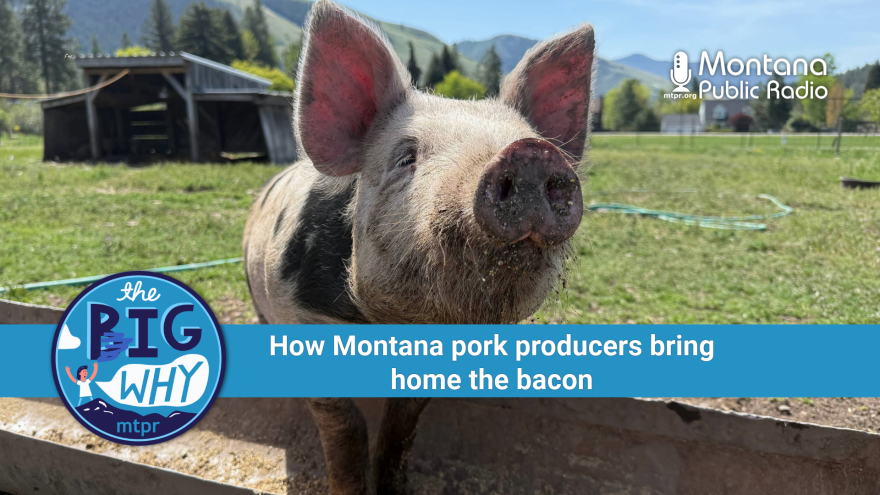This week’s topic comes from a listener who asks, ‘Why is there no hog industry in Montana?’ While Montana famously has more cows than people, as we dug into this question, we found out that pigs are a big deal in Montana.
Austin Amestoy: Welcome to The Big Why, a series from Montana Public Radio where we find out what we can discover together. I'm your host, Austin Amestoy. This is a show about listener-powered reporting. We'll answer questions, big or small, about anything under the Big Sky. By Montanans, for Montana, this is The Big Why – or as we’re affectionately calling this episode – The Pig Why.
Reporter Edward O’Brien joins us again today.
Edward O'Brien: Hey Austin, and excellent wordsmithing here as usual. Well played!
Austin Amestoy: Help us parse out this episode’s porcine theme.
Edward O'Brien: Well, This week’s topic comes from a listener who asks, ‘Why is there no hog industry in Montana?’
Austin Amestoy: Interesting. When I think Montana livestock, I mostly picture cattle and sheep.
Edward O'Brien: You’re not alone. While Montana famously has more cows than people, as I dug into this question, I found out our pork industry is truly compelling. Sure, it’s a fraction of the size of the major players in the Midwest. But from farm to table – and even to the classroom – pigs are a big deal in Montana.
Austin Amestoy: Intriguing. Let's start with some context. How many pigs are actually raised in Montana?
Edward O'Brien: Sure. According to Montana Fish, Wildlife and Parks, Montana has roughly 225,000 hogs.
Austin Amestoy: That is more than I was expecting.
Edward O'Brien: For perspective, the nation’s top pork producing state, Iowa, boasts an impressive 23 million hogs.
Ken Kleinsasser: I think a lot of people may not know that we actually have a hog industry.
Edward O'Brien: Ken Kleinsasser is a farmer from north central Montana. He lives and works on the Hilldale Hutterite colony north of Havre.
Austin Amestoy: The Hutterites – a communal, agrarian religious group, right?
Edward O'Brien: Correct. The Hutterites are generally considered Montana’s top pork producers. And one of the more striking things Kleinsasser, who sits on the board of the Montana Pork Producers Council, told me was:
Ken Kleinsasser: Amongst the Hutterite community in Montana, I think the hog industry has never been stronger.
Austin Amestoy: Hmm … why’s he say that?
Edward O'Brien: About 15 years ago, the colonies made a major operational change that Kleinsasser says made a world of difference in their hog operations.
Edward O'Brien: Back in the day the Hutterites would fatten and finish the hogs before shipping them east for slaughter. These days they’re shipping them out shortly after the piglets have been weaned.
Ken Kleinsasser: There's obviously a lot of freight in a 300 pound hog, and now it's 15 pound hog at a fraction of cost to ship it out.
Edward O'Brien: He says Montana’s now shipping over seven times the number of hogs than were being freighted out nearly two decades ago.
Kleinsasser also touts the work ethic of Hutterite farm managers.
Ken Kleinsasser: It's a great advantage that we have and we're able to run our barns much more efficient.
Austin Amestoy: So, an impressive work ethic, cost effectively shipping pigs out at younger ages, both leading to growing exports. It sounds pretty robust to me, Ed. So why does the Midwest completely dominate the pig market?
Edward O'Brien: It's pretty simple, actually. Montana just can’t compete with what, say, Iowa, brings to the table. According to the Iowa Pork Producers Association nearly one third of the nation’s hogs are raised there. There’s a massive concentration of livestock-related labor and infrastructure in the Hawkeye state. Think: meat processing plants in particular. Montana doesn’t even have a fraction of Iowa’s processing capability.

Austin Amestoy: So, to get back to the listener’s question. Montana does in fact have a hog industry, it’s just not as big as some other parts of the country. Is Montana’s Hutterite community the state’s only pork producers?
Edward O'Brien: The dominant producers, yes, but certainly not the only ones. There are several smaller operations scattered throughout the state.
Roxie Davis: This is Roxie Davis and I’m representing Lyon Ranch in Drummond, MT.
Edward O'Brien: For a long time the Davis family ranch was a cattle operation. Now she and her husband are diversifying into some milk cows, goats, chickens, ducks, geese, peacocks.
Roxie Davis: It’s sort of Old MacDonald’s Farm.
Edward O'Brien: And yes, hogs. Davis tells me these are heritage breeds with great names reflecting their deep English roots: Berkshires, Durochs and Gloucestershire Old Spots.
Roxie Davis: The meat is a good red meat and when you eat it you feel like you're eating pork that we all had at our grandmother's houses, I guess.
Austin Amestoy: Where do they market their pork?
Edward O'Brien: They sell to retailers, direct to consumer, restaurants and now farm-to-market sellers like Oxbow Meats and Mountain Meat Shares. Earlier this year, three of Davis’ pigs went to a community, neighborhood farm in Missoula, a reminder that Montana’s hog industry has a presence even on the micro level.
The PEAS farm is a 10 acre slice of bucolic heaven at the north end of Missoula’s Rattlesnake Valley. It serves a lot of functions, including as a farm to school program for local K-12 students. The three little pigs purchased from Roxie Davis live in a huge pen complete with shelter, a wallow and million dollar views of the north Missoula valley.
Austin Amestoy: That sounds like pretty good living to me, Ed. You used the phrase ‘farm to school’. What’s that mean?
Edward O'Brien: Essentially, the team educates young folks about agriculture – tells them where their food comes from.
Jason Mandala is Garden City Harvest’s Farm to School Director:
Jason Mandala: And that’s part of the point of having children up here, is we want to lift the veil of the food system just a little bit. A lot of what happens in our food system is kind of hidden from us.

Edward O'Brien: He says his team offers gentle and age-appropriate conversations with visiting school kids to help them understand that, by this autumn, these pigs will be transformed into food.
Austin Amestoy: A difficult lesson. How do these kids react?
Edward O'Brien: He says some kids absorb the lesson and roll with it. Sometimes the reactions are emotionally challenging, which he says is equally natural and healthy. Mandala says the little ones who participate always ask neat questions which usually spark great conversation.
Austin Amestoy: No doubt. What kinds of things do they hear?
Edward O'Brien: A common one: ‘What are the pigs names?’
Jason Mandala: Well, we don’t name them. While we care about them and we want them to have good lives here, we don’t want to become attached to.
Edward O'Brien: The point, according to Mandala, isn’t to indoctrinate visitors, but to educate and inform.
Jason Mandala: And if they want to go flex their muscle in certain ways to represent the way they feel by buying food that more aligns with their ethics and morals, that’s all we’re trying to do up here.
Edward O'Brien: So, Austin, as you can see, Montana certainly does have a hog industry. While it’s nothing like the conglomerate pork producers’ footprint or power in the Midwest, Montana’s larger producers say they’re always learning important lessons and growing despite our lack of infrastructure. Our smaller niche producers, meanwhile, keep exploring new markets.
Back in Drummond, the Lyon Ranch’s Roxie Davis wants to see smaller producers succeed. She says it’s important in terms of more humane treatment for animals, healthier food for consumers and Montana’s economic strength.
Austin Amestoy: Alright, so hogs may not be pig business in Montana, but it’s an important industry nonetheless.
Austin Amestoy: Thanks for sharing your reporting, Ed.
Edward O'Brien: Of course, and thank you for the opportunity.
Austin Amestoy: Now we want to know what makes you curious about Montana. Submit your questions below, or leave a message at 406-640-8933. Let's see what we can discover together! Find us wherever you listen to podcasts and help others find the show by sharing it and leaving a review.







